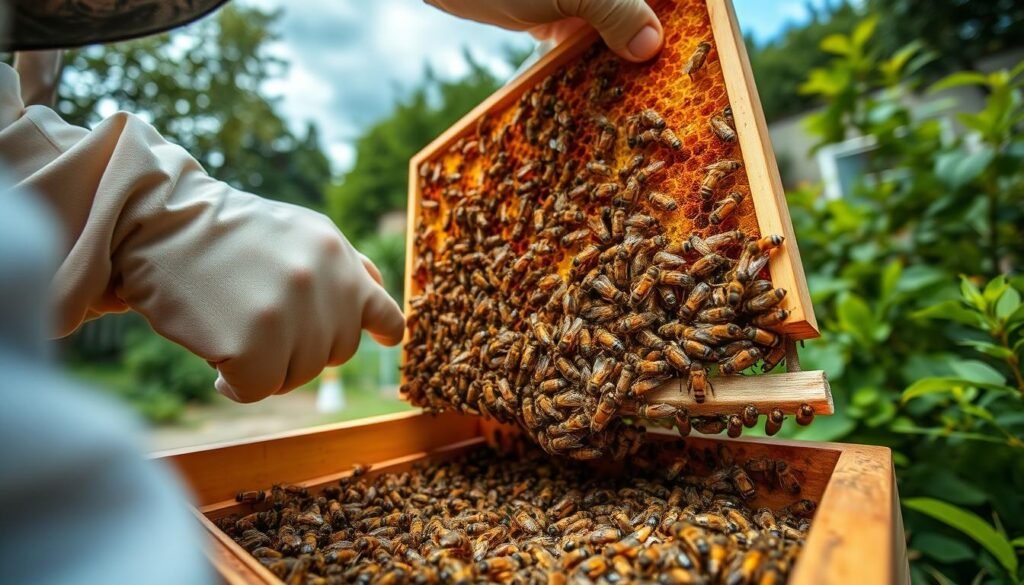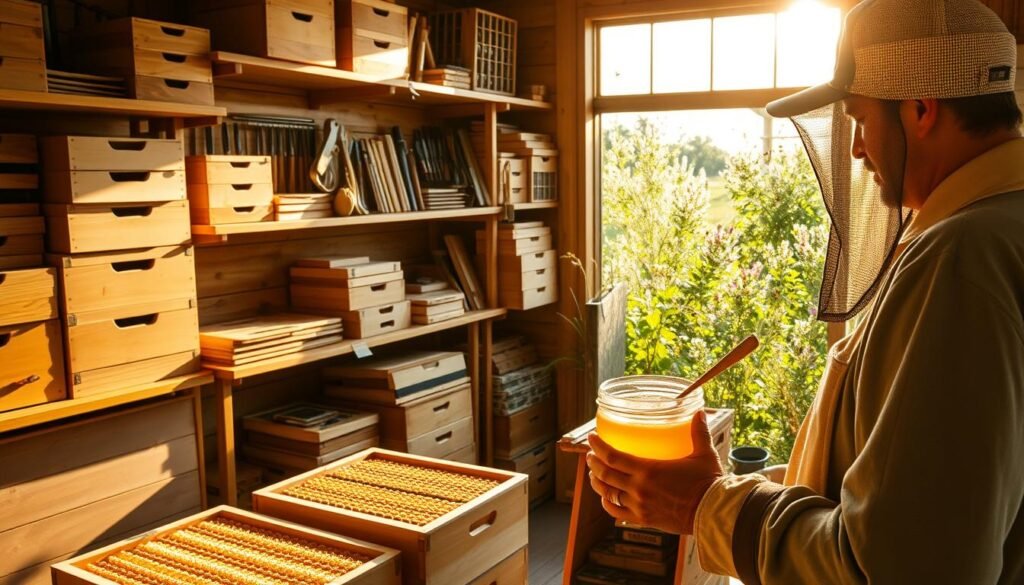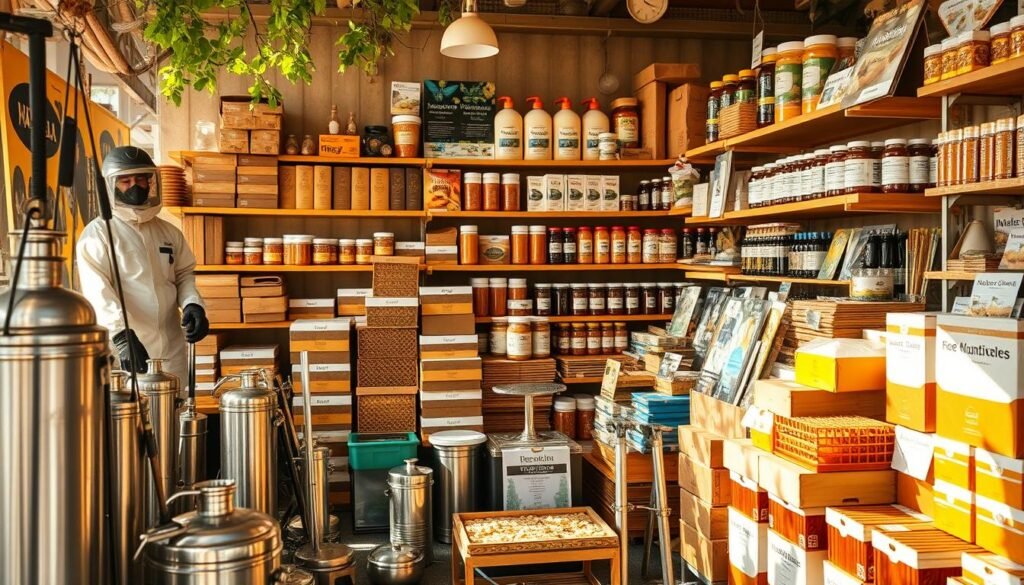Since their arrival in 1822 aboard the Isabella, European Honey Bees have shaped Australia’s agricultural landscape. These industrious pollinators now contribute over $500 million annually to exports through almond crop pollination – a process requiring billions of insects along the Murray River each spring. Yet when colonies settle in urban areas, balancing safety and conservation becomes critical.
Melbourne homeowners often face buzzing visitors establishing hives in walls, roofs, or gardens. While honey production and crop support remain vital, misplaced colonies risk stinging incidents and structural damage. Professional removal experts assess each situation, distinguishing between introduced species and Australia’s 2,000 native varieties – a key factor in determining safe relocation strategies.
Modern approaches focus on preserving healthy colonies rather than extermination. Specialists use protective gear and eco-friendly methods to transfer insects to apiaries, supporting both urban safety and Victoria’s thriving beekeeping industry. This careful process also adheres to livestock regulations, ensuring relocated bees continue benefiting ecosystems and agriculture.
Key Takeaways
- European Honey Bees drive Victoria’s almond industry, requiring specialised handling during removal
- Professional services safely relocate colonies without harming ecosystems
- Native and introduced species demand different management approaches
- DIY removal risks legal breaches and safety hazards
- Healthy hives support agricultural productivity when properly managed
Introduction to Bee Removal and Control in Melbourne
Pollinators contribute over $16 billion annually to Australia’s agricultural economy, with thousands of species working silently to sustain ecosystems. While European varieties dominate crop pollination, most local species live solitary lives – a critical distinction shaping removal strategies.
The Role of Bees in Our Ecosystems
These insects evolved from wasps 150 million years ago, developing specialised hairs to collect nectar and pollen. Today, they maintain food security by supporting 75% of flowering plants and 35% of global crops. Native varieties like stingless bees pollinate unique flora found nowhere else.
Urban colonies face unique survival challenges. Improper handling risks:
- Disrupting pollination networks
- Triggering defensive swarms
- Damaging protected species
Why Professional Bee Removal is Essential
Attempting DIY removal often backfires. Untrained individuals might misidentify species, breach wildlife laws, or provoke stinging incidents. Certified specialists use thermal imaging and behavioural knowledge to relocate entire colonies safely.
Key professional advantages include:
- Preserving queen bees during transfers
- Selecting apiaries matching hive needs
- Preventing structural damage during extraction
Understanding Bee Biology and Behaviour in Australia
Australia’s buzzing residents showcase nature’s adaptability, with introduced and native species developing distinct survival strategies over millennia. These differences shape how experts approach hive management and relocation.
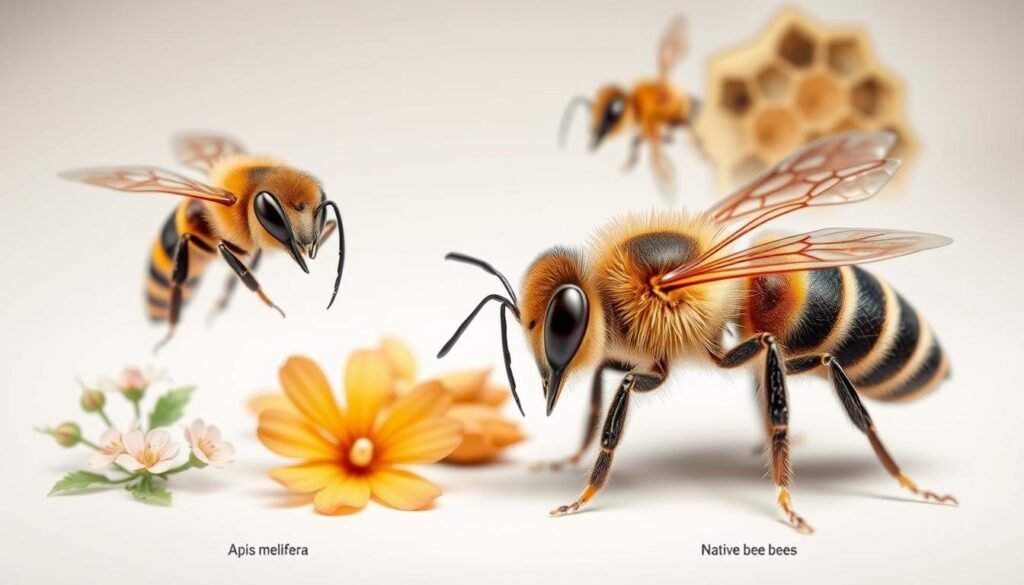
European Honey Bees vs Australian Native Bees
Introduced European honey bees form colonies of 50,000+ members ruled by a single queen. Their complex social structure contrasts sharply with 99% of native species that live solitary lives. While European varieties build wax hives in cavities, most Australian natives nest in soil or tree hollows.
Physical differences matter too. Native species evolved short tongues to access Myrtaceae family flowers like eucalypts. Only 11 local varieties produce honey, and none create commercial-grade wax. Their smooth stingers allow multiple defensive strikes, unlike European bees’ barbed stingers that prove fatal after one use.
Insights into Bee Colony Dynamics and Life Cycles
Honey bee colonies operate like superorganisms. Workers communicate through intricate dances and pheromones, creating coordinated defences during removal attempts. Spring flowering triggers population explosions, making this peak season for swarm activity.
Native species follow simpler cycles. Solitary females lay eggs in underground chambers or plant stems, with no worker caste to protect them. This fundamental biological contrast explains why relocation methods differ dramatically between species types.
Why Bee Behaviour Impacts Removal Techniques
Locating the queen becomes critical when relocating European colonies. “Without transferring the matriarch, the entire hive collapses,” explains apiarist Dr. Eliza Nguyen. Professionals use thermal sensors to track her pheromone signature while avoiding defensive swarms.
Ground-nesting natives require gentler approaches. Specialists often leave solitary nests undisturbed, focusing instead on sealing entry points. Understanding these behavioural nuances prevents ecological disruption while keeping homes safe.
Identifying Unwanted Bee Colonies in Your Backyard
Spring’s arrival often brings more than blossoming gardens – increased insect activity signals potential colony formation. Homeowners should monitor their properties for specific indicators of permanent settlements rather than casual foraging visits.
Recognising Signs of Bee Infestation
Consistent aerial traffic near structures reveals hidden hives. Watch for groups entering gaps in walls or roof beams during morning hours. Listen for faint buzzing behind surfaces – a telltale sign of cavity-dwelling colonies.
Structural clues include wax deposits around cracks or sticky propolis sealing gaps. European varieties often leave smooth entry holes, while ground-nesting species create small soil mounds. Leaf-cutter types leave distinctive half-moon marks on foliage.
Common Nesting Sites in Residential Areas
Protected spaces attract different species:
- Wall voids & attics: European honey bee hotspots
- Hollow trees & bamboo stakes: Native blue-banded bee habitats
- Soft mortar & timber: Carpenter bee targets
Ground nests appear as pencil-sized holes in garden beds. Mudbrick homes sometimes host resin-sealed burrows in exterior walls. Early detection prevents structural damage and supports safe relocation.
Local Strategies for bees melbourne Removal
Victoria’s framework for managing relocated insects combines legal compliance with ecological stewardship. Strict registration rules through the BeeMAX system ensure traceability, while hive placement standards protect communities from overcrowded colonies.
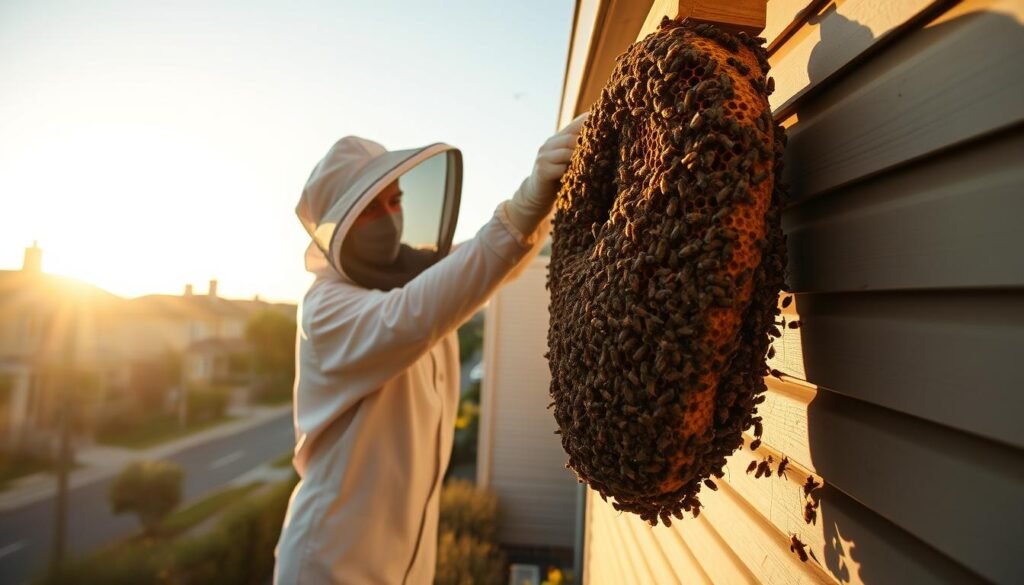
Integrating Safe Removal Practices
Certified specialists follow a dual mandate: resolving human-wildlife conflicts while sustaining pollination networks. Each relocation begins with assessing colony type and size. European varieties often get transferred to almond orchards, while native species move to bushland reserves.
Key considerations include:
- Queen identification for colony stability
- Weather patterns affecting transport success
- Flowering cycles at relocation sites
When to Hire a Professional Apiarist
Complex cases demand expert intervention. Structural infestations requiring wall dismantling or colonies near schools typically need licensed handlers. Professionals carry $20 million liability coverage and use temperature-controlled transport units.
Seasoned apiarists excel in:
- Preventing secondary swarming during extraction
- Matching colony traits with apiary needs
- Documenting transfers for agricultural authorities
Partnerships between removal services and beekeeping groups create closed-loop systems. Relocated insects continue supporting Victoria’s food production while reducing urban risks – a balance achieved through skilled, regulation-aware practices.
Bee Removal Tools, Equipment, and Protective Gear
Effective colony management relies on purpose-built tools and specialised protective equipment. Professionals use gear designed to calm insects while preventing stings during extraction. Proper tools also minimise hive damage, preserving valuable comb structures for relocation.
Essential Tools and Hive Access Equipment
Beekeeping supplies include hive tools for prying apart sticky frames and boxes. Smokers with 100mm barrels create cool smoke that masks alarm pheromones. Experts prefer 8-frame hives for easier handling compared to bulkier 10-frame designs.
| Feature | 8-Frame Hive | 10-Frame Hive |
|---|---|---|
| Weight (full) | 18-22kg | 27-32kg |
| Handling | Easier solo operation | Requires team lifting |
| Common Use | Urban removals | Commercial apiaries |
| Transport | Fits standard vehicles | Needs specialised racks |
Proper Protective Clothing and Safety Measures
Light-coloured clothing reduces defensive reactions – dark fabrics trigger aggression. Full-body suits with elastic cuffs prevent gaps, while ventilated veils protect faces without restricting vision. Leather gloves with extended sleeves shield hands during frame transfers.
Seasoned handlers check weather forecasts before operations. Rain increases bee irritability, while extreme heat stresses colonies during transport. Proper tool maintenance ensures smooth separations of wax-sealed components, reducing disturbance times.
Steps for Handling and Removing Bee Colonies Safely
Effective colony relocation demands precise planning and execution to protect both insects and property. Specialists follow proven protocols that maintain hive integrity while preventing future infestations.
Pre-Removal Assessment and Planning
Experts begin by mapping entry points and structural vulnerabilities. Thermal imaging helps locate brood chambers hidden in walls. This step determines equipment needs and potential risks like weakened roof beams.
A Step-by-Step Safe Removal Process
Cool smoke calms defensive behaviour before comb extraction. Workers gently transfer frames containing brood patterns and honey stores into nucleus boxes. Protecting the queen ensures colony cohesion during transport.
Key phases include:
- Isolating the queen in a separate cage
- Preserving 3-4 functional combs per nucleus
- Sealing boxes to prevent escape during relocation
Post-Removal Hive Management and Cleanup
New apiary sites require abundant nectar sources and predator protection. Beekeepers monitor queen acceptance through egg-laying patterns. Residual pheromones at removal sites get neutralised with citrus-based cleaners to deter recolonisation.
Essential follow-up actions:
- Installing mesh screens over cavity openings
- Providing sugar syrup supplements during establishment
- Conducting weekly health checks for 45 days
Preventative Measures and Post-Removal Maintenance
Securing properties against future infestations requires strategic planning paired with ongoing vigilance. Addressing structural vulnerabilities while supporting local ecosystems creates lasting protection for homes and beneficial pollinators.
Property Sealing and Future Infestation Prevention
Inspect buildings seasonally for gaps wider than 3mm – common entry points near rooflines or pipes. Use steel wool or silicone sealant to block cavities, focusing on areas showing previous activity. Trim overhanging branches near walls to disrupt flight paths.
Landscaping choices matter. Replace flowering shrubs near foundations with rosemary or lavender – less attractive to swarming colonies. Install bee hotels in garden corners to redirect solitary species from structures.
Regular Monitoring and Maintenance Practices
Conduct monthly checks during peak seasons using non-invasive methods like infrared cameras. Look for fresh wax deposits or increased insect traffic around sealed zones. Clean gutters regularly to prevent water accumulation that attracts scouts.
Those practising backyard beekeeping should schedule professional hive inspections twice yearly. Proper maintenance prevents overcrowding that leads to swarming. Record activity patterns to anticipate seasonal risks and adjust prevention strategies.

